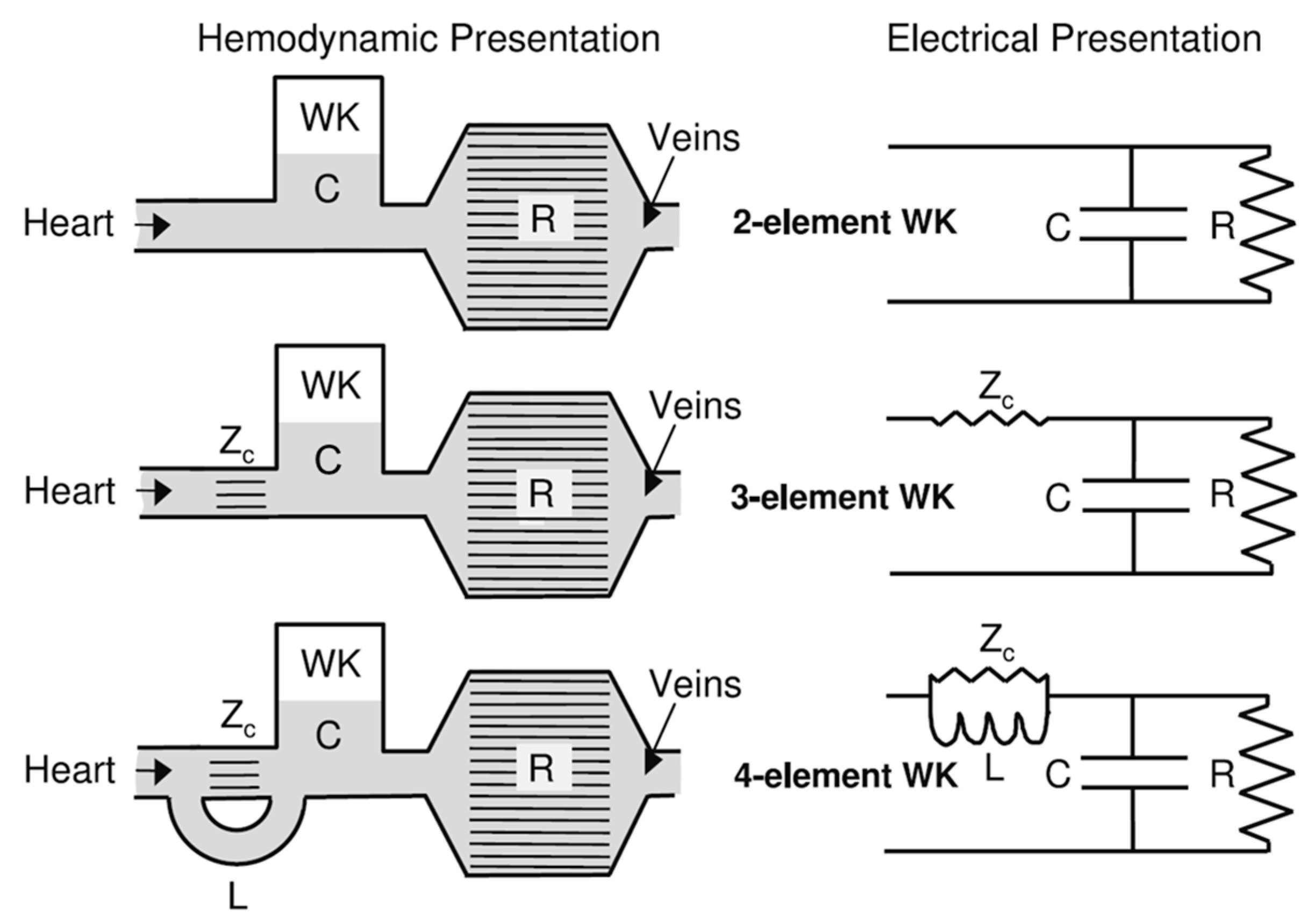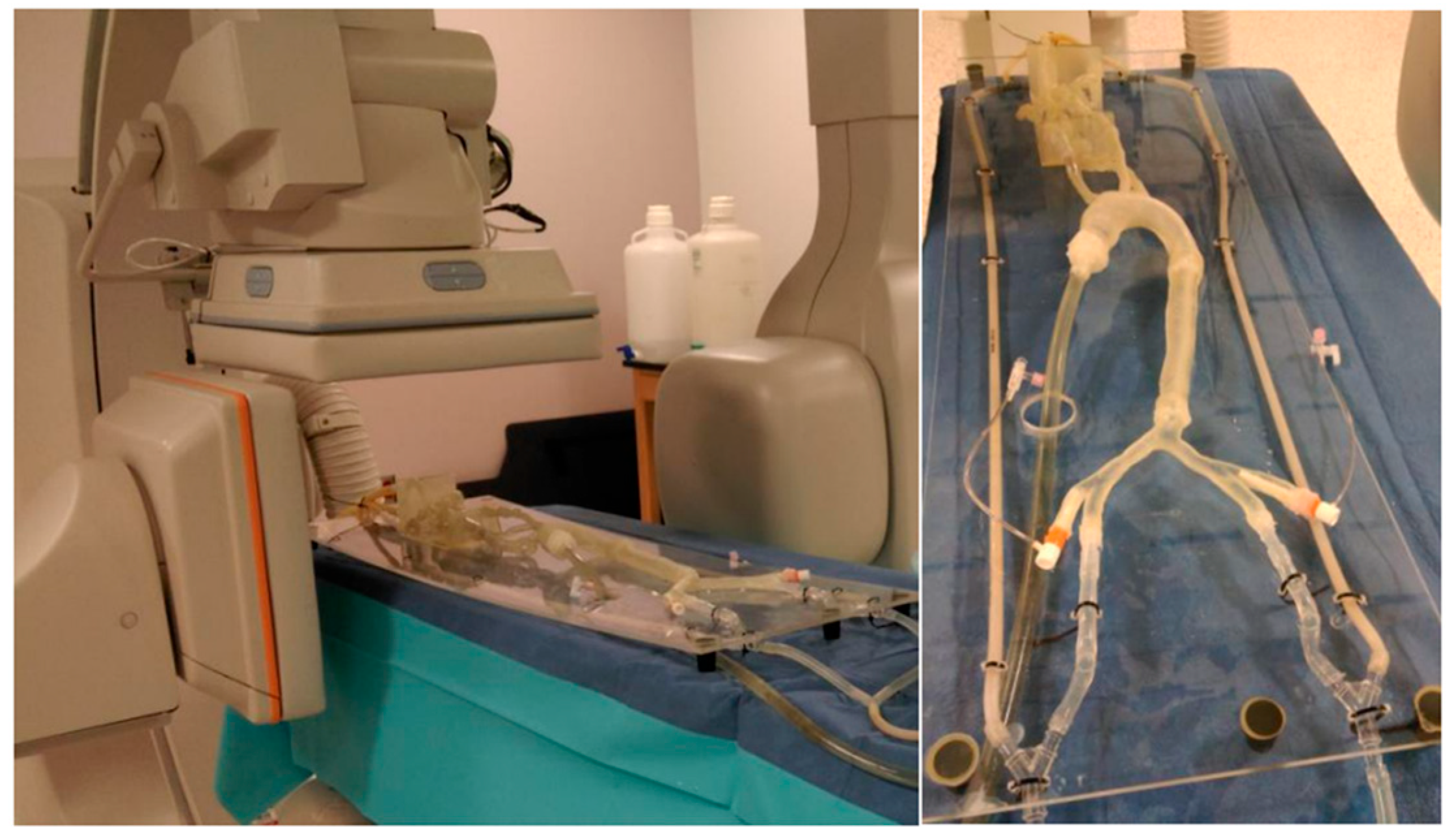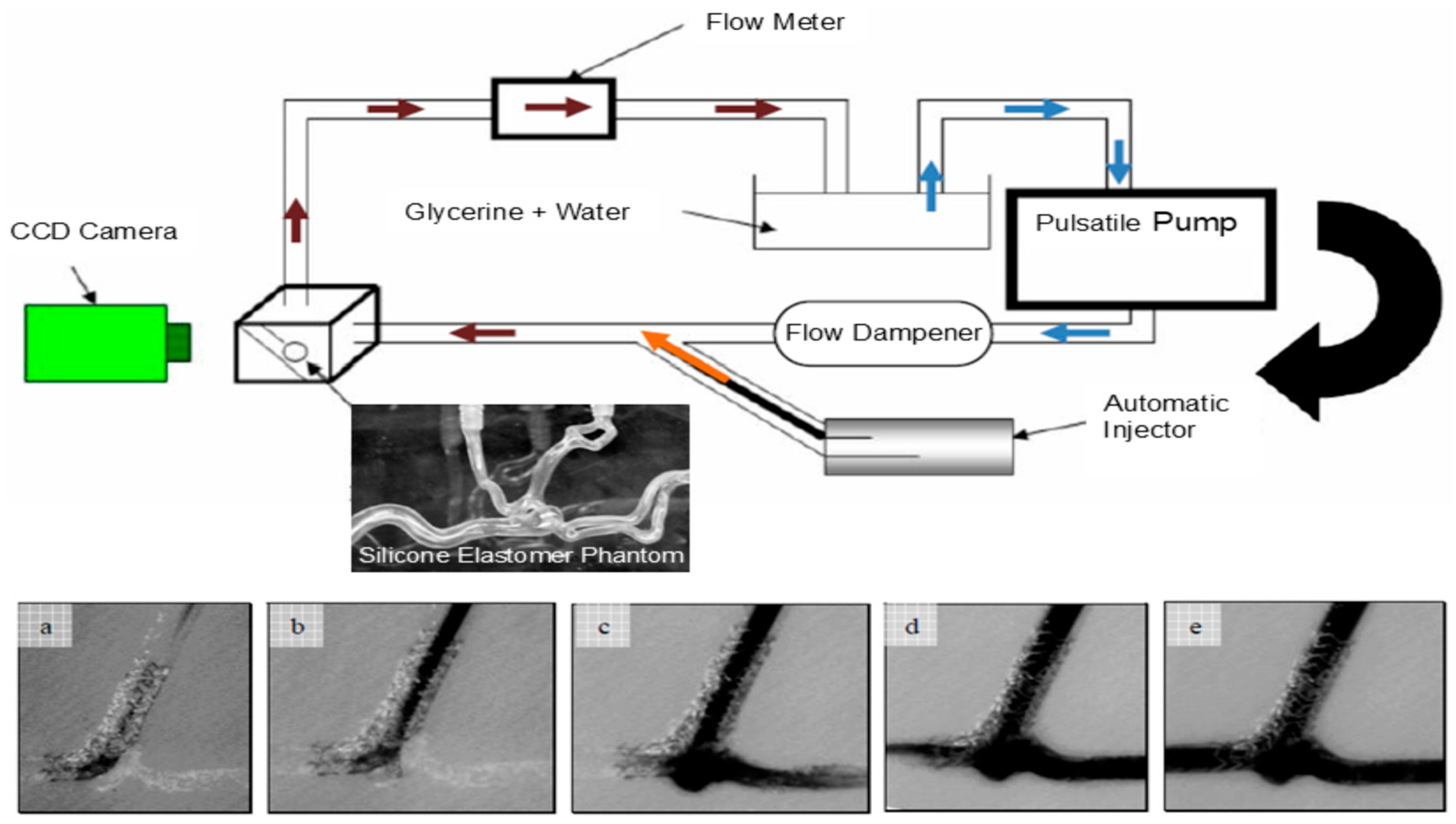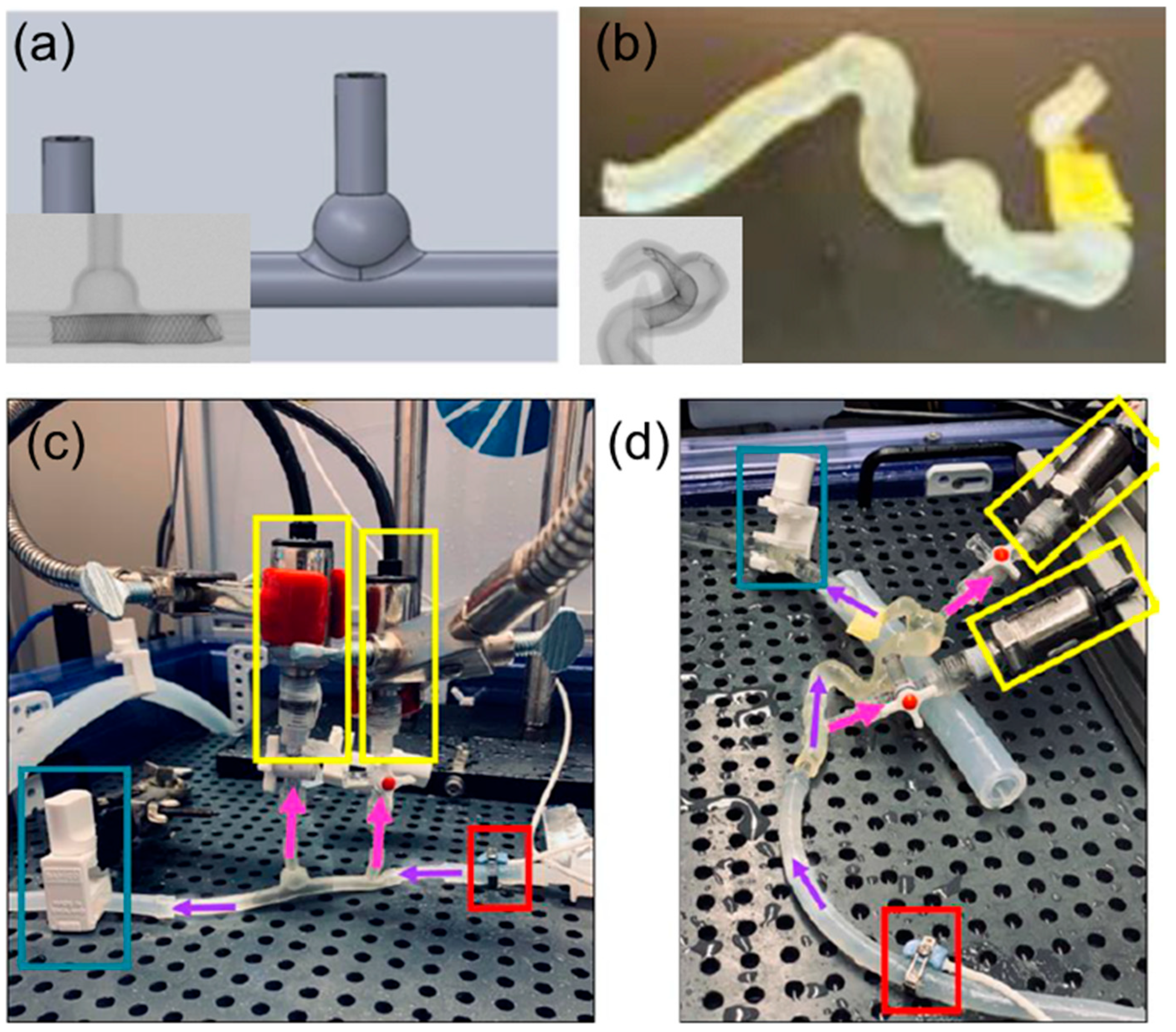A Comprehensive Review of Mock Circulation Loop Systems for Experimental Hemodynamics of Cardiovascular Diseases
Abstract
1. Introduction
2. Key Components of an MCL
2.1. Pulsatile Pump
2.2. Compliance Chambers
2.3. Resistance Valves/Resistors
3. Applications in Surgical Planning
3.1. Interventional Procedure Optimization
3.2. Preclinical and Surgery Evaluations
3.3. Patient-Specific Surgical Planning
4. MCLs in Cardiovascular Disease Studies
4.1. Stenosis
4.2. Aneurysm
4.3. Peripheral Artery Disease
5. Challenges and Limitations
6. Summary
Author Contributions
Funding
Institutional Review Board Statement
Informed Consent Statement
Data Availability Statement
Conflicts of Interest
Abbreviations
| 3D | 3-Dimensional |
| CTA | Computed Tomography Angiogram |
| CVDs | Cardiovascular Diseases |
| MCLs | Mock Circulation Loops |
| micro-CT | Micro-Computed Tomography |
| MRI | Magnetic Resonance Imaging |
| PAD | Peripheral Artery Disease |
| SVR | Systemic Vascular Resistance |
| VADs | Ventricular Assist Devices |
References
- Tsao, C.W.; Aday, A.W.; Almarzooq, Z.I.; Anderson, C.A.; Arora, P.; Avery, C.L.; Baker-Smith, C.M.; Beaton, A.Z.; Boehme, A.K.; Buxton, A.E. Heart disease and stroke statistics—2023 update: A report from the American Heart Association. Circulation 2023, 147, e93–e621. [Google Scholar]
- Donovan, F. Design of a hydraulic analog of the circulatory system for evaluating artificial hearts. Biomater. Med. Devices Artif. Organs 1975, 3, 439–449. [Google Scholar] [CrossRef]
- Elefteriades, J.A. Thoracic aortic aneurysm: Reading the enemy’s playbook. Curr. Probl. Cardiol. 2008, 33, 203–277. [Google Scholar] [CrossRef]
- Marsh, J.D.; Keyrouz, S.G. Stroke prevention and treatment. J. Am. Coll. Cardiol. 2010, 56, 683–691. [Google Scholar] [CrossRef]
- Kemp, C.D.; Conte, J.V. The pathophysiology of heart failure. Cardiovasc. Pathol. 2012, 21, 365–371. [Google Scholar] [CrossRef]
- Kullo, I.J.; Rooke, T.W. Peripheral artery disease. N. Engl. J. Med. 2016, 374, 861–871. [Google Scholar] [CrossRef]
- Fuster, V.; Moreno, P.R.; Fayad, Z.A.; Corti, R.; Badimon, J.J. Atherothrombosis and high-risk plaque: Part I: Evolving concepts. J. Am. Coll. Cardiol. 2005, 46, 937–954. [Google Scholar] [CrossRef]
- Secomb, T.W. Hemodynamics. Compr. Physiol. 2016, 6, 975. [Google Scholar] [CrossRef]
- Gimbrone, M.A., Jr.; García-Cardeña, G. Vascular endothelium, hemodynamics, and the pathobiology of atherosclerosis. Cardiovasc. Pathol. 2013, 22, 9–15. [Google Scholar] [CrossRef]
- Lieber, B.B.; Stancampiano, A.P.; Wakhloo, A.K. Alteration of hemodynamics in aneurysm models by stenting: Influence of stent porosity. Ann. Biomed. Eng. 1997, 25, 460–469. [Google Scholar] [CrossRef]
- Hirsch, A.T.; Haskal, Z.J.; Hertzer, N.R.; Bakal, C.W.; Creager, M.A.; Halperin, J.L.; Hiratzka, L.F.; Murphy, W.R.; Olin, J.W.; Puschett, J.B. ACC/AHA 2005 practice guidelines for the management of patients with peripheral arterial disease (lower extremity, renal, mesenteric, and abdominal aortic) a collaborative report from the American Association for Vascular Surgery/Society for Vascular Surgery,* Society for Cardiovascular Angiography and Interventions, Society for Vascular Medicine and Biology, Society of Interventional Radiology, and the ACC/AHA Task Force on Practice Guidelines (writing committee to develop guidelines for the management of patients with peripheral arterial disease): Endorsed by the American Association of Cardiovascular and Pulmonary Rehabilitation; National Heart, Lung, and Blood Institute; Society for Vascular Nursing; TransAtlantic Inter-Society Consensus; and Vascular Disease Foundation. Circulation 2006, 113, e463–e654. [Google Scholar]
- Harvey, W.; Willis, R. The Works of William Harvey; Sydenham Society: London, UK, 1847; Volume 11. [Google Scholar]
- Booth, J. A short history of blood pressure measurement. Proc. R. Soc. Med. 1977, 70, 793–799. [Google Scholar] [CrossRef]
- Frank, O. The basic shape of the arterial pulse. First treatise: Mathematical analysis. J. Mol. Cell. Cardiol. 1990, 22, 255–277. [Google Scholar] [CrossRef]
- Ionita, C.N.; Mokin, M.; Varble, N.; Bednarek, D.R.; Xiang, J.; Snyder, K.V.; Siddiqui, A.H.; Levy, E.I.; Meng, H.; Rudin, S. Challenges and limitations of patient-specific vascular phantom fabrication using 3D Polyjet printing. In Proceedings of the Medical Imaging 2014: Biomedical Applications in Molecular, Structural, and Functional Imaging, San Diego, CA, USA, 16–18 February 2014. [Google Scholar]
- Colacino, F.M.; Moscato, F.; Piedimonte, F.; Danieli, G.; Nicosia, S.; Arabia, M. A Modified Elastance Model to Control Mock Ventricles in Real-Time: Numerical and Experimental Validation. ASAIO J. 2008, 54, 563–573. [Google Scholar] [CrossRef]
- Gregory, S.D.; Greatrex, N.; Timms, D.; Gaddum, N.; Pearcy, M.J.; Fraser, J.F. Simulation and enhancement of a cardiovascular device test rig. J. Simul. 2010, 4, 34–41. [Google Scholar] [CrossRef]
- Meess, K.M.; Izzo, R.L.; Dryjski, M.L.; Curl, R.E.; Harris, L.M.; Springer, M.; Siddiqui, A.H.; Rudin, S.; Ionita, C.N. 3D printed abdominal aortic aneurysm phantom for image guided surgical planning with a patient specific fenestrated endovascular graft system. In Proceedings of the Medical Imaging 2017: Imaging Informatics for Healthcare, Research, and Applications, Orlando, FL, USA, 15–16 February 2017. [Google Scholar]
- Russ, M.; O’Hara, R.; Nagesh, S.S.; Mokin, M.; Jimenez, C.; Siddiqui, A.; Bednarek, D.; Rudin, S.; Ionita, C. Treatment planning for image-guided neuro-vascular interventions using patient-specific 3D printed phantoms. In Proceedings of the Medical Imaging 2015: Biomedical Applications in Molecular, Structural, and Functional Imaging, Orlando, Fl, USA, 24–26 February 2015. [Google Scholar]
- Allman, A.B.; Bhurwani, M.M.S.; Senko, J.L.; Rava, R.A.; Podgorsak, A.R.; Rudin, S.; Ionita, C.N. Use of 3D printed intracranial aneurysm phantoms to test the effect of flow diverters geometry on hemodynamics. In Proceedings of the Medical Imaging 2020: Imaging Informatics for Healthcare, Research, and Applications, Houston, TX, USA, 16–20 February 2020. [Google Scholar]
- Thaker, R.; Araujo-Gutierrez, R.; Marcos-Abdala, H.G.; Agrawal, T.; Fida, N.; Kassi, M. Innovative modeling techniques and 3D printing in patients with left ventricular assist devices: A bridge from bench to clinical practice. J. Clin. Med. 2019, 8, 635. [Google Scholar] [CrossRef]
- Chaudhury, R.A.; Atlasman, V.; Pathangey, G.; Pracht, N.; Adrian, R.J.; Frakes, D.H. A high performance pulsatile pump for aortic flow experiments in 3-dimensional models. Cardiovasc. Eng. Technol. 2016, 7, 148–158. [Google Scholar] [CrossRef]
- Yu, H.; Khan, M.; Wu, H.; Du, X.; Chen, R.; Rollins, D.; Fang, X.; Long, J.; Xu, C.; Sawchuk, A. A new noninvasive and patient-specific hemodynamic index for assessing the severity of renal arterial stenosis. Int. J. Numer. Methods Biomed. Eng 2022, 38, e3611. [Google Scholar] [CrossRef]
- Yu, H.; Khan, M.; Wu, H.; Zhang, C.; Du, X.; Chen, R.; Fang, X.; Long, J.; Sawchuk, A.P. Inlet and outlet boundary conditions and uncertainty quantification in volumetric lattice boltzmann method for image-based computational hemodynamics. Fluids 2022, 7, 30. [Google Scholar] [CrossRef]
- Zhang, X.; Gomez-Paz, J.; Chen, X.; McDonough, J.M.; Islam, M.M.; Andreopoulos, Y.; Zhu, L.; Yu, H. Volumetric lattice Boltzmann method for wall stresses of image-based pulsatile flows. Sci. Rep. 2022, 12, 1697. [Google Scholar] [CrossRef]
- Yu, H. Non-Invasive Functional Assessment Technique for Determining Hemodynamic Severity of an Arterial Stenosis. U.S. Patent 11,538,153, 27 December 2022. [Google Scholar]
- An, S.; Yu, H.; Islam, M.M.; Zhang, X.; Zhan, Y.; Olivieri, J.J.; Ambati, J.; Yao, J.; Gelfand, B.D. Effects of donor-specific microvascular anatomy on hemodynamic perfusion in human choriocapillaris. Sci. Rep. 2023, 13, 22666. [Google Scholar] [CrossRef]
- Shang, B.; Chen, R.; Yan, W.; Yu, H.W. GPU accelerated volumetric lattice Boltzmann model for image-based hemodynamics in portal hypertension. Comput. Fluids 2023, 266, 106038. [Google Scholar] [CrossRef]
- Paccione, E.; Ionita, C.N. Challenges in hemodynamics assessment in complex neurovascular geometries using computational fluid dynamics and benchtop flow simulation in 3D printed patient-specific phantoms. In Proceedings of the Medical Imaging 2021: Biomedical Applications in Molecular, Structural, and Functional Imaging, Meloneras, Spain, 15–19 February 2021. [Google Scholar]
- Shepard, L.M.; Sommer, K.N.; Paccione, E.; Mokin, M.; Siddiqui, A.H.; Snyder, K.V.; Levy, E.I.; Davies, J.M.; Rudin, S.; Ionita, C.N. Use of 3D-printed patient-specific neurovascular phantoms to investigate the correlation between disease severity and quantitative angiography results. In Proceedings of the Medical Imaging 2020: Imaging Informatics for Healthcare, Research, and Applications, Houston, TX, USA, 15–20 February 2020. [Google Scholar]
- Pantalos, G.M.; Koenig, S.C.; Gillars, K.J.; Giridharan, G.A.; Ewert, D.L. Characterization of an adult mock circulation for testing cardiac support devices. ASAIO J. 2004, 50, 37–46. [Google Scholar] [CrossRef]
- Timms, D.; Hayne, M.; McNeil, K.; Galbraith, A. A complete mock circulation loop for the evaluation of left, right, and biventricular assist devices. Artif. Organs 2005, 29, 564–572. [Google Scholar] [CrossRef]
- Timms, D.L.; Gregory, S.D.; Greatrex, N.A.; Pearcy, M.J.; Fraser, J.F.; Steinseifer, U. A compact mock circulation loop for the in vitro testing of cardiovascular devices. Artif. Organs 2011, 35, 384–391. [Google Scholar] [CrossRef]
- Sénage, T.; Février, D.; Michel, M.; Pichot, E.; Duveau, D.; Tsui, S.; Trochu, J.N.; Roussel, J.C. A mock circulatory system to assess the performance of continuous-flow left ventricular assist devices (LVADs): Does axial flow unload better than centrifugal LVAD? ASAIO J. 2014, 60, 140–147. [Google Scholar] [CrossRef]
- Kolyva, C.; Biglino, G.; Pepper, J.R.; Khir, A.W. A mock circulatory system with physiological distribution of terminal resistance and compliance: Application for testing the intra-aortic balloon pump. Artif. Organs 2012, 36, E62–E70. [Google Scholar] [CrossRef]
- Najjari, M.R.; Plesniak, M.W. PID controller design to generate pulsatile flow rate for in vitro experimental studies of physiological flows. Biomed. Eng. Lett. 2017, 7, 339–344. [Google Scholar] [CrossRef]
- Verdonck, P.; Kleven, A.; Verhoeven, R.; Angelsen, B.; Vandenbogaerde, J. Computer-controlled in vitro model of the human left heart. Med. Biol. Eng. Comput. 1992, 30, 656–659. [Google Scholar] [CrossRef]
- Nestler, F.; Bradley, A.P.; Wilson, S.J.; Timms, D.L.; Frazier, O.H.; Cohn, W.E. A hybrid mock circulation loop for a total artificial heart. Artif. Organs 2014, 38, 775–782. [Google Scholar] [CrossRef]
- Westerhof, N.; Elzinga, G.; Sipkema, P. An artificial arterial system for pumping hearts. J. Appl. Physiol. 1971, 31, 776–781. [Google Scholar] [CrossRef]
- Hong, W.; Yu, H.; Chen, J.; Talamantes, J.; Rollins, D.M.; Fang, X.; Long, J.; Xu, C.; Sawchuk, A.P. A mock circulation loop to characterize in vitro hemodynamics in human systemic arteries with stenosis. Fluids 2023, 8, 198. [Google Scholar] [CrossRef]
- Scholz, A.M.; Bünger, L.; Kongsro, J.; Baulain, U.; Mitchell, A.D. Non-invasive methods for the determination of body and carcass composition in livestock: Dual-energy X-ray absorptiometry, computed tomography, magnetic resonance imaging and ultrasound: Invited review. Animal 2015, 9, 1250–1264. [Google Scholar] [CrossRef]
- Grossman, W. Cardiac Catheterization and Angiography, 3rd ed.; OSTI: Oak Ridge, TN, USA, 1986.
- Kennedy, J.W.; Baxley, W.A.; Bunnel, I.L.; Gensini, G.G.; Messer, J.V.; Mudd, J.G.; Noto, T.J.; Paulin, S.; Pichard, A.D.; Sheldon, W.C. Mortality related to cardiac catheterization and angiography. Catheter. Cardiovasc. Diagn. 1982, 8, 323–340. [Google Scholar] [CrossRef] [PubMed]
- Chaikof, E.L.; Mutrie, C.; Kasirajan, K.; Milner, R.; Chen, E.P.; Veeraswamy, R.K.; Dodson, T.F.; Salam, A.A. Endovascular repair for diverse pathologies of the thoracic aorta: An initial decade of experience. J. Am. Coll. Surg. 2009, 208, 802–816. [Google Scholar] [CrossRef]
- Booher, A.M.; Isselbacher, E.M.; Nienaber, C.A.; Trimarchi, S.; Evangelista, A.; Montgomery, D.G.; Froehlich, J.B.; Ehrlich, M.P.; Oh, J.K.; Januzzi, J.L. The IRAD classification system for characterizing survival after aortic dissection. Am. J. Med. 2013, 126, 730.e19–730.e24. [Google Scholar] [CrossRef] [PubMed]
- Mukherjee, D.; Cho, L. Peripheral arterial disease: Considerations in risks, diagnosis, and treatment. J. Natl. Med. Assoc. 2009, 101, 999–1008. [Google Scholar] [CrossRef]
- Dey, S.; Mukherjee, D. Clinical perspectives on the role of anti-platelet and statin therapy in patients with vascular diseases. Curr. Vasc. Pharmacol. 2003, 1, 329–333. [Google Scholar] [CrossRef]
- Reicher, B.; Poston, R.S.; Mehra, M.R.; Joshi, A.; Odonkor, P.; Kon, Z.; Reyes, P.A.; Zimrin, D.A. Simultaneous “hybrid” percutaneous coronary intervention and minimally invasive surgical bypass grafting: Feasibility, safety, and clinical outcomes. Am. Heart J. 2008, 155, 661–667. [Google Scholar] [CrossRef]
- Agostoni, P.; Biondi-Zoccai, G.G.; De Benedictis, M.L.; Rigattieri, S.; Turri, M.; Anselmi, M.; Vassanelli, C.; Zardini, P.; Louvard, Y.; Hamon, M. Radial versus femoral approach for percutaneous coronary diagnostic and interventional procedures: Systematic overview and meta-analysis of randomized trials. J. Am. Coll. Cardiol. 2004, 44, 349–356. [Google Scholar] [CrossRef]
- Werner, J.; Feuerbach, S.; Uhl, W.; Büchler, M. Management of acute pancreatitis: From surgery to interventional intensive care. Gut 2005, 54, 426–436. [Google Scholar] [CrossRef]
- Bleilevens, C.; Hill, A.; Grzanna, T.; Fechter, T.; Bohnen, M.; Weber, H.-J.; Beckers, C.; Borosch, S.; Zayat, R.; Benstoem, C. In vitro head-to-head comparison of anticoagulation properties of two heparin brands in a human blood miniature mock loop. Interact. Cardiovasc. Thorac. Surg. 2019, 28, 120–127. [Google Scholar] [CrossRef] [PubMed]
- Cappon, F.; Wu, T.; Papaioannou, T.; Du, X.; Hsu, P.-L.; Khir, A.W. Mock circulatory loops used for testing cardiac assist devices: A review of computational and experimental models. Int. J. Artif. Organs 2021, 44, 793–806. [Google Scholar] [CrossRef] [PubMed]
- Khudzari, A.; Kadir, M.; Osman, K.; Hudzari, A. Mock circulatory loop for cardiovascular assist device testing. In Cardiovascular Engineering: Technological Advancements, Reviews, and Applications; Spinger: Berlin/Heidelberg, Germany, 2019; pp. 177–200. [Google Scholar]
- Shi, Y.; Yang, H. Mock circulatory test rigs for the in vitro testing of artificial cardiovascular organs. J. Med. Eng. Technol. 2019, 43, 223–234. [Google Scholar] [CrossRef]
- Xu, K.-W.; Gao, Q.; Wan, M.; Zhang, K. Mock circulatory loop applications for testing cardiovascular assist devices and in vitro studies. Front. Physiol. 2023, 14, 1175919. [Google Scholar] [CrossRef] [PubMed]
- Peter, L.; Noury, N.; Cerny, M. Proposal of Physical Model of Cardiovascular System; Improvement of Mock Circulatory Loop. In World Congress on Medical Physics and Biomedical Engineering 2018, Prague, Czech Republic, 3–8 June 2018; Springer Nature Singapore: Singapore, 2019. [Google Scholar]
- Spurlock, D.J.; Raney, D.N.; Fracz, E.M.; Mazur, D.E.; Bartlet, R.; Haft, J.W. In vitro testing of a novel blood pump designed for temporary extracorporeal support. Asaio J. 2012, 58, 109–114. [Google Scholar] [CrossRef][Green Version]
- Mazur, D.E.; Osterholzer, K.R.; Toomasian, J.M.; Merz, S.I. A novel, low cost, disposable, pediatric pulsatile rotary ventricular pump for cardiac surgery that provides a physiological flow pattern. ASAIO J. 2008, 54, 523–528. [Google Scholar] [CrossRef]
- Timms, D.; Hayne, M.; Tan, A.; Pearcy, M. Evaluation of left ventricular assist device performance and hydraulic force in a complete mock circulation loop. Artif. Organs 2005, 29, 573–580. [Google Scholar] [CrossRef]
- Herreros, J.; Berjano, E.J.; Sales-Nebot, L.; Más, P.; Calvo, I.; Mastrobuoni, S.; Mercé, S. A new method of providing pulsatile flow in a centrifugal pump: Assessment of pulsatility using a mock circulatory system. Artif. Organs 2008, 32, 490–494. [Google Scholar] [CrossRef]
- Timms, D. A review of clinical ventricular assist devices. Med. Eng. Phys. 2011, 33, 1041–1047. [Google Scholar] [CrossRef]
- Gregory, S.D. Simulation and Development of a Mock Circulation Loop with Variable Compliance. Ph.D. Thesis, Queensland University of Technology, Brisbane, Australia, 2009. [Google Scholar]
- Wang, Y.; Smith, P.; Wheeler, J.; John, M.; Broda, C.; Frazier, O.; Taylor, D.; Sampaio, L. A 4-chamber model heart with 3d printed silicone aorta and peripheral arteries to simulate the human cardiovascular system in a mock circulatory loop. J. Heart Lung Transplant. 2019, 38, S342. [Google Scholar] [CrossRef]
- Lee, K.B.; Sun, K.; Kim, H.W.; Chang, J.K.; Park, C.Y.; Chung, C.; Kim, J.K.; Kim, J.; Kim, H.M. Effective reduction of blood cell damage by using a compliance chamber in a pulsatile extracorporeal life support system. ASAIO J. 2000, 46, 233. [Google Scholar] [CrossRef]
- Belz, G.G. Elastic properties and Windkessel function of the human aorta. Cardiovasc. Drugs Ther. 1995, 9, 73–83. [Google Scholar] [CrossRef] [PubMed]
- Westerhof, N.; Lankhaar, J.-W.; Westerhof, B.E. The arterial windkessel. Med. Biol. Eng. Comput. 2009, 47, 131–141. [Google Scholar] [CrossRef]
- Catanho, M.; Sinha, M.; Vijayan, V. Model of Aortic Blood Flow Using the Windkessel Effect; University of California of San Diago: San Diago, CA, USA, 2012. [Google Scholar]
- Mansouri, M.; Gregory, S.D.; Salamonsen, R.F.; Lovell, N.H.; Stevens, M.C.; Pauls, J.P.; Akmeliawati, R.; Lim, E. Preload-based Starling-like control of rotary blood pumps: An in-vitro evaluation. PLoS ONE 2017, 12, e0172393. [Google Scholar] [CrossRef]
- Taylor, C.E.; Miller, G.E. Mock circulatory loop compliance chamber employing a novel real-time control process. J. Med. Devices 2012, 6, 045003. [Google Scholar] [CrossRef]
- Gregory, S.D.; Pauls, J.P.; Wu, E.L.; Stephens, A.; Steinseifer, U.; Tansley, G.; Fraser, J.F. An advanced mock circulation loop for in vitro cardiovascular device evaluation. Artif. Organs 2020, 44, E238–E250. [Google Scholar] [CrossRef]
- de Jong, M.M.; Parise, O.; Matteucci, F.; Rutten, M.; Devos, M.; Romano, M.; Micali, L.R.; Parise, G.; Maessen, J.G.; Gelsomino, S. Aortic flow below and visceral circulation during aortic counterpulsation: Evaluation of an in vitro model. Perfusion 2020, 37, 69–77. [Google Scholar] [CrossRef]
- Malone, A.; Chari, D.; Cournane, S.; Naydenova, I.; Fagan, A.; Browne, J. Investigation of the assessment of low degree (<50%) renal artery stenosis based on velocity flow profile analysis using Doppler ultrasound: An in-vitro study. Phys. Medica 2019, 65, 209–218. [Google Scholar]
- Santamore, W.P.; Kent, R.L.; Carey, R.A.; Bove, A.A. Synergistic effects of pressure, distal resistance, and vasoconstriction on stenosis. Am. J. Physiol.-Heart Circ. Physiol. 1982, 243, H236–H242. [Google Scholar] [CrossRef]
- Lankhaar, J.-W.; Westerhof, N.; Faes, T.J.; Marques, K.M.; Marcus, J.T.; Postmus, P.E.; Vonk-Noordegraaf, A. Quantification of right ventricular afterload in patients with and without pulmonary hypertension. Am. J. Physiol.-Heart Circ. Physiol. 2006, 291, H1731–H1737. [Google Scholar] [CrossRef]
- Rezaienia, M.; Paul, G.; Avital, E.; Mozafari, S.; Rothman, M.; Korakianitis, T. In-vitro investigation of the hemodynamic responses of the cerebral, coronary and renal circulations with a rotary blood pump installed in the descending aorta. Med. Eng. Phys. 2017, 40, 2–10. [Google Scholar] [CrossRef]
- Li, X.; Li, Z.; Chen, D. A mock circulation loop for in vitro haemodynamic evaluation of aorta. J. Phys. Conf. Ser. 2020, 1600, 012066. [Google Scholar] [CrossRef]
- Leopaldi, A.; Vismara, R.; Van Tuijl, S.; Redaelli, A.; van de Vosse, F.; Fiore, G.B.; Rutten, M. A novel passive left heart platform for device testing and research. Med. Eng. Phys. 2015, 37, 361–366. [Google Scholar] [CrossRef]
- Biglino, G.; Verschueren, P.; Zegels, R.; Taylor, A.M.; Schievano, S. Rapid prototyping compliant arterial phantoms for in-vitro studies and device testing. J. Cardiovasc. Magn. Reson. 2013, 15, 2. [Google Scholar] [CrossRef]
- Ochsner, G.; Amacher, R.; Amstutz, A.; Plass, A.; Daners, M.S.; Tevaearai, H.; Vandenberghe, S.; Wilhelm, M.J.; Guzzella, L. A novel interface for hybrid mock circulations to evaluate ventricular assist devices. IEEE Trans. Biomed. Eng. 2012, 60, 507–516. [Google Scholar] [CrossRef]
- Mokin, M.; Waqas, M.; Nagesh, S.V.S.; Karkhanis, N.V.; Levy, E.I.; Ionita, C.N.; Siddiqui, A.H. Assessment of distal access catheter performance during neuroendovascular procedures: Measuring force in three-dimensional patient specific phantoms. J. Neurointerventional Surg. 2019, 11, 619–622. [Google Scholar] [CrossRef]
- Agrafiotis, E.; Mayer, C.; Grabenwöger, M.; Zimpfer, D.; Regitnig, P.; Mächler, H.; Holzapfel, G.A. Global and local stiffening of ex vivo-perfused stented human thoracic aortas: A mock circulation study. Acta Biomater. 2023, 161, 170–183. [Google Scholar] [CrossRef]
- Sherman, J.; Rangwalla, H.; Dohatcu, A.; Minsuok, K.; Ionita, C.; Rudin, S. SU-FF-I-127: Patient Specific Angiography Phantoms for Investigating New Endovascular Image-Guided Interventional (EIGI) Devices. Med. Phys. 2007, 34, 2367. [Google Scholar] [CrossRef]
- Sherman, J.; Rangwala, H.S.; Ionita, C.N.; Dohatcu, A.; Lee, J.; Bednarek, D.R.; Hoffmann, K.R.; Rudin, S. Investigation of new flow modifying endovascular image-guided interventional (EIGI) techniques in patient-specific aneurysm phantoms (PSAPs) using optical imaging. In Proceedings of the Medical Imaging 2008: Visualization, Image-Guided Procedures, and Modeling, San Diego, CA, USA, 16–21 February 2008. [Google Scholar]
- Rangwala, H.S.; Ionita, C.N.; Rudin, S.; Baier, R.E. Partially polyurethane-covered stent for cerebral aneurysm treatment. J. Biomed. Mater. Res. Part B Appl. Biomater. Off. J. Soc. Biomater. Jpn. Soc. Biomater. Aust. Soc. Biomater. Korean Soc. Biomater. 2009, 89, 415–429. [Google Scholar] [CrossRef]
- Cloonan, A.J.; Shahmirzadi, D.; Li, R.X.; Doyle, B.J.; Konofagou, E.E.; McGloughlin, T.M. 3D-printed tissue-mimicking phantoms for medical imaging and computational validation applications. 3D Print. Addit. Manuf. 2014, 1, 14–23. [Google Scholar] [CrossRef]
- Jang, J.; Yi, H.-G.; Cho, D.-W. 3D printed tissue models: Present and future. ACS Biomater. Sci. Eng. 2016, 2, 1722–1731. [Google Scholar] [CrossRef]
- Liaw, C.-Y.; Guvendiren, M. Current and emerging applications of 3D printing in medicine. Biofabrication 2017, 9, 024102. [Google Scholar] [CrossRef]
- Tejo-Otero, A.; Buj-Corral, I.; Fenollosa-Artés, F. 3D printing in medicine for preoperative surgical planning: A review. Ann. Biomed. Eng. 2020, 48, 536–555. [Google Scholar] [CrossRef]
- Sommer, K.N.; Bhurwani, M.M.S.; Tutino, V.; Siddiqui, A.; Davies, J.; Snyder, K.; Levy, E.; Mokin, M.; Ionita, C.N. Use of patient specific 3D printed neurovascular phantoms to simulate mechanical thrombectomy. 3D Print. Med. 2021, 7, 32. [Google Scholar] [CrossRef]
- Tan, K.; Van Beek, E.; Brown, P.; Van Delden, O.; Tijssen, J.; Ramsay, L. Magnetic resonance angiography for the diagnosis of renal artery stenosis: A meta-analysis. Clin. Radiol. 2002, 57, 617–624. [Google Scholar] [CrossRef]
- Westra, J.; Tu, S.; Winther, S.; Nissen, L.; Vestergaard, M.-B.; Andersen, B.K.; Holck, E.N.; Fox Maule, C.; Johansen, J.K.; Andreasen, L.N. Evaluation of coronary artery stenosis by quantitative flow ratio during invasive coronary angiography: The WIFI II study (wire-free functional imaging II). Circ. Cardiovasc. Imaging 2018, 11, e007107. [Google Scholar] [CrossRef]
- Holmstedt, C.A.; Turan, T.N.; Chimowitz, M.I. Atherosclerotic intracranial arterial stenosis: Risk factors, diagnosis, and treatment. Lancet Neurol. 2013, 12, 1106–1114. [Google Scholar] [CrossRef]
- Agrafiotis, E.; Zimpfer, D.; Mächler, H.; Holzapfel, G.A. Review of Systemic Mock Circulation Loops for Evaluation of Implantable Cardiovascular Devices and Biological Tissues. J. Endovasc. Ther. 2024, 15266028241235876. [Google Scholar] [CrossRef]








Disclaimer/Publisher’s Note: The statements, opinions and data contained in all publications are solely those of the individual author(s) and contributor(s) and not of MDPI and/or the editor(s). MDPI and/or the editor(s) disclaim responsibility for any injury to people or property resulting from any ideas, methods, instructions or products referred to in the content. |
© 2025 by the authors. Licensee MDPI, Basel, Switzerland. This article is an open access article distributed under the terms and conditions of the Creative Commons Attribution (CC BY) license (https://creativecommons.org/licenses/by/4.0/).
Share and Cite
Hong, W.; Tewari, V.; Chen, J.; Sawchuk, A.P.; Yu, H. A Comprehensive Review of Mock Circulation Loop Systems for Experimental Hemodynamics of Cardiovascular Diseases. Fluids 2025, 10, 166. https://doi.org/10.3390/fluids10070166
Hong W, Tewari V, Chen J, Sawchuk AP, Yu H. A Comprehensive Review of Mock Circulation Loop Systems for Experimental Hemodynamics of Cardiovascular Diseases. Fluids. 2025; 10(7):166. https://doi.org/10.3390/fluids10070166
Chicago/Turabian StyleHong, Weichen, Vijay Tewari, Jun Chen, Alan P. Sawchuk, and Huidan Yu. 2025. "A Comprehensive Review of Mock Circulation Loop Systems for Experimental Hemodynamics of Cardiovascular Diseases" Fluids 10, no. 7: 166. https://doi.org/10.3390/fluids10070166
APA StyleHong, W., Tewari, V., Chen, J., Sawchuk, A. P., & Yu, H. (2025). A Comprehensive Review of Mock Circulation Loop Systems for Experimental Hemodynamics of Cardiovascular Diseases. Fluids, 10(7), 166. https://doi.org/10.3390/fluids10070166







